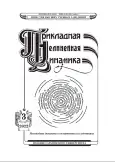Measuring cognitive potential based on the performance of tasks of various levels of complexity
- Authors: Petukhov A.Y.1, Polevaia S.A.2
-
Affiliations:
- Keldysh Institute of Applied Mathematics of RAS
- Lobachevsky State University of Nizhny Novgorod
- Issue: Vol 30, No 3 (2022)
- Pages: 311-321
- Section: Articles
- URL: https://journals.rcsi.science/0869-6632/article/view/252083
- DOI: https://doi.org/10.18500/0869-6632-2022-30-3-311-321
- ID: 252083
Cite item
Full Text
Abstract
About the authors
Aleksandr Y. Petukhov
Keldysh Institute of Applied Mathematics of RAS
ORCID iD: 0000-0002-7412-5397
603950 Nizhny Novgorod, Gagarin Avenue, 23
Sofia Alexandrovna Polevaia
Lobachevsky State University of Nizhny Novgorod
ORCID iD: 0000-0002-3896-787X
603950 Nizhny Novgorod, Gagarin Avenue, 23
References
- Александров Ю. И. Психофизиологические закономерности научения и методы обучения // Психологический журнал. 2012. Т. 33, № 6. С. 5-19.
- Кожевников В. В., Полевая С. А., Шишалов И. С., Бахчина А. В. Мобильный HR-измеритель (HR-измеритель). Свидетельство о государственной регистрации программ для ЭВМ 2014618634 от 26.08.2014.
- Vandekerckhove J. A cognitive latent variable model for the simultaneous analysis of behavioral and personality data // Journal of Mathematical Psychology. 2014. Vol. 60. P. 58-71. doi: 10.1016/j.jmp.2014.06.004.
- Faugeras O., Inglis J. Stochastic neural field equations: a rigorous footing // Journal of Mathematical Biology. 2015. Vol. 71, no. 2. P. 259-300. doi: 10.1007/s00285-014-0807-6.
- Kooi B. W. Modelling the dynamics of traits involved in fighting-predators-prey system // Journal of Mathematical Biology. 2015. Vol. 71, no. 6-7. P. 1575-1605. doi: 10.1007/s00285-015-0869-0.
- Haazebroek P., van Dantzig S., Hommel B. A computational model of perception and action for cognitive robotics // Cognitive Processing. 2011. Vol. 12, no. 4. P. 355. doi: 10.1007/s10339-011-0408-x.
- Geukes S., Gaskell M. G., Zwitserlood P. Stroop effects from newly learned color words: effects of memory consolidation and episodic context // Frontiers in Psychology. 2015. Vol. 6. P. 278. doi: 10.3389/fpsyg.2015.00278.
- Полевая С. А., Еремин Е. В., Буланов Н. А., Бахчина А. В., Ковальчук А. В., Парин С. Б. Событийно-связанная телеметрия ритма сердца для персонифицированного дистанционного мониторинга когнитивных функций и стресса в условиях естественной деятельности // Современные технологии в медицине. 2019. T. 11, № 1. C. 109-115. doi: 10.17691/stm2019.11.1.13.
- Almeria M., Cejudo J. C., Sotoca J., Deus J., Krupinski J. Cognitive profile following COVID-19 infection: Clinical predictors leading to neuropsychological impairment // Brain, Behavior, & Immunity - Health. 2020. Vol. 9. P. 100163. doi: 10.1016/j.bbih.2020.100163.
- Анохин К. В. Генные зонды для картирования нервных сетей при обучении // Принципы и механизмы деятельности мозга человека. Л.: Наука, 1989. С. 191-192.
- Petukhov A. Y., Polevaya S. A., Yakhno V. G. The theory of information images: Modeling based on diffusion equations // International Journal of Biomathematics. 2016. Vol. 9, no. 6. P. 1650087. doi: 10.1142/S179352451650087X.
- Petukhov A. Y., Polevaya S. A. Modeling of communicative individual interactions through the theory of information images // Current Psychology. 2017. Vol. 36, no. 3. P. 428-433. doi: 10.1007/s12144-016-9431-5.
- Petukhov A. Y., Polevaya S. A. Modeling of cognitive brain activity through the information images theory in terms of the bilingual Stroop test // International Journal of Biomathematics. 2017. Vol. 10, no. 7. P. 1750092. doi: 10.1142/S1793524517500929.
- Petukhov A. Y., Polevaya S. A., Polevaya A. V. Experimental diagnostics of the emotional state of individuals using external stimuli and a model of neurocognitive brain activity // Diagnostics. 2022. Vol. 12, no. 1. P. 125. doi: 10.3390/diagnostics12010125.
- Friston K. J., Price C. J. Dynamic representations and generative models of brain function // Brain Research Bulletin. 2001. Vol. 54, no. 3. P. 275-285. doi: 10.1016/S0361-9230(00)00436-6.
- Guclu U., van Gerven M. A. J. Modeling the dynamics of human brain activity with recurrent neural networks // Frontiers in Computational Neuroscience. 2017. Vol. 11. P. 7. doi: 10.3389/fncom.2017.00007.
- Herweg N. A., Kahana M. J. Spatial representations in the human brain // Frontiers in Human Neuroscience. 2018. Vol. 12. P. 297. doi: 10.3389/fnhum.2018.00297.
Supplementary files










